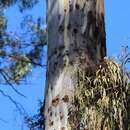en
names in breadcrumbs


Perception Channels: tactile ; chemical
Since Petaurus australis is strongly tied to certain species of eucalypt trees, removal or damage to these trees results in habitat reduction. Eucalypt forests in Australia are cut for timber or cleared for agricultural purposes. It is also apparent that removal of old growth elements from unlogged forests or from previously lightly-logged forests results in a decline in density of these animals. Because the species requires a variety of trees to feed on in mixed forest over large home ranges, and because it needs hollow trees for nesting, its conservation requires the preservation of large tracts of forests.
Besides reduction of habitat from logging, there is evidence that expansion of rainforest into the wet sclerophyll forests preferred by Petaurus australis also has diminished its range. Rainforest expansion is believed to be due to a reduction in the intensity of fires along the western margins of rainforests, possibly caused by controlled burning of undergrowth by cattle ranchers. (Environment Australia Biodiversity Group; WIRES NSW; Harrington and Sanderson 1994; Lindenmayer et al., 1999)
US Federal List: no special status
CITES: no special status
IUCN Red List of Threatened Species: least concern
nothing found
nothing found
The diet of Petaurus australis consists largely of nectar, pollen, and the sap of eucalypts. Sap is obtained by incising the bark on the upper branches and trunks of Eucalyptus resinifera trees and drinking the ooze. Some individual trees are clearly favored and become very heavily scarred. Its diet also includes insects, arachnids, grubs, and possibly small vertebrates. (WIRES NSW; Craig, 1985)
Petaurus australis occurs in native eucalypt forests along the eastern and southeastern coasts of Australia in Queensland, New South Wales, and Victoria. It ranges inland as much as several hundred kilometers and has an extensive, but patchy distribution. It is generally found in low densities and considered rare throughout most of its range, although it can be locally common (e.g. as in east Gippsland). (Environment Australia Biodiversity Group, 1999)
Biogeographic Regions: australian (Native )
Petaurus australis lives in coastal and open foothill forest and woodland, and in wet eucalypt forests. In eastern Australia it lives only in tall, mature eucalypt forests in regions of high rainfall, with temperate to subtropical climates. The northern Queensland population lives in forests at high altitudes with lower temperatures. It occurs in greatest numbers in coastal and foothill forest and woodland, and in lesser numbers in wet eucalypt forests. Winter flowering eucalypts (e.g. Eucalyptus maculata) may be important in habitat preference in southern Queensland. High densities seen in New South Wales may correlate to a continuous supply of nectar due to a greater diversity of eucalypts. (Environment Australia Biodiversity Group; WIRES NSW)
Terrestrial Biomes: forest
Average lifespan
Status: captivity: 10.0 years.
Average lifespan
Status: wild: 10.0 years.
Body length in Petaurus australis ranges from 27 to 30 cm, and tail length ranges from 42 to 48 cm. Its pouch has two incompletely divided compartments divided by a well developed septum, a feature unique among marsupials. The fur is fine and silky. Its tail is prehensile and fully covered in fur. Its coloration is dusky gray-brown dorsally and creamy to yellowish-orange ventrally, with black feet and an oblique dark strip on its thigh. It has semi-naked ears and a pink nose. A gliding membrane is connected from its wrists and ankles. Males are larger than females. (WIRES NSW; Nowak, 1991)
Range mass: 435 to 710 g.
Other Physical Features: endothermic ; bilateral symmetry
Mating has been observed while pairs were clinging to the underside of a branch. Females have two nipples in the incompletely divided pouch. Typically, females bear a single young, although twins have been observed. Breeding is limited to August through December in Victoria but occurs throughout the year in Queensland. Young are carried in the mother's pouch for about 100 days, after which time they are left in a nest for an additional 60 days. Both parents provide care for the young, which become independent after 18 to 24 months, and become sexually mature at about 2 years of age. (WIRES NSW; Nowak, 1991; Craig, 1985, Goldingay, 1992).
Key Reproductive Features: gonochoric/gonochoristic/dioecious (sexes separate); sexual
Average number of offspring: 1.
Average age at sexual or reproductive maturity (female)
Sex: female: 725 days.